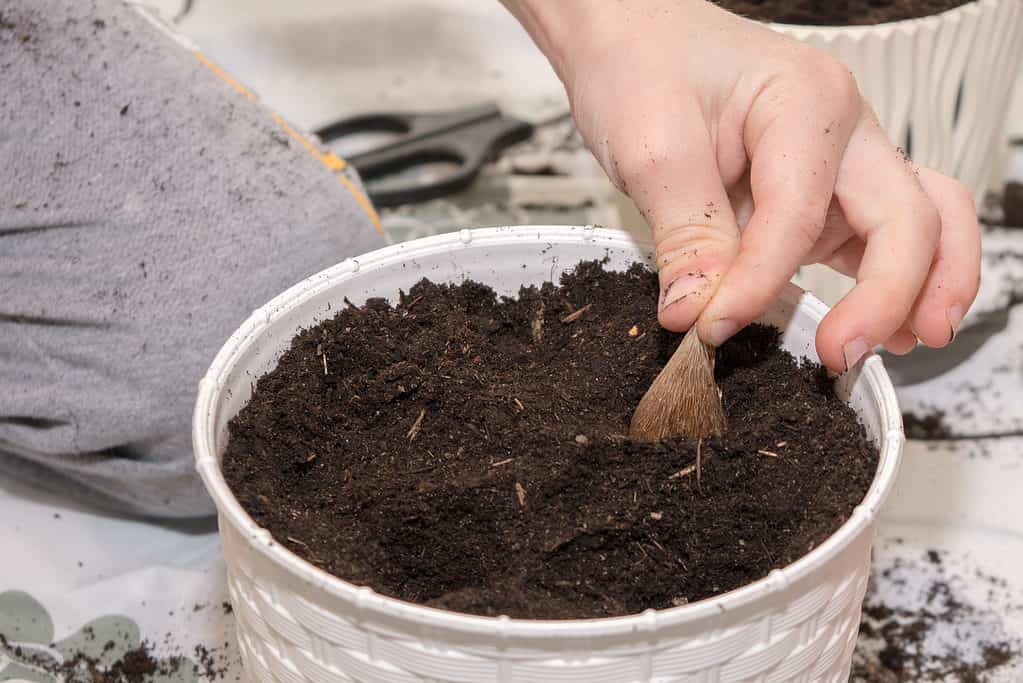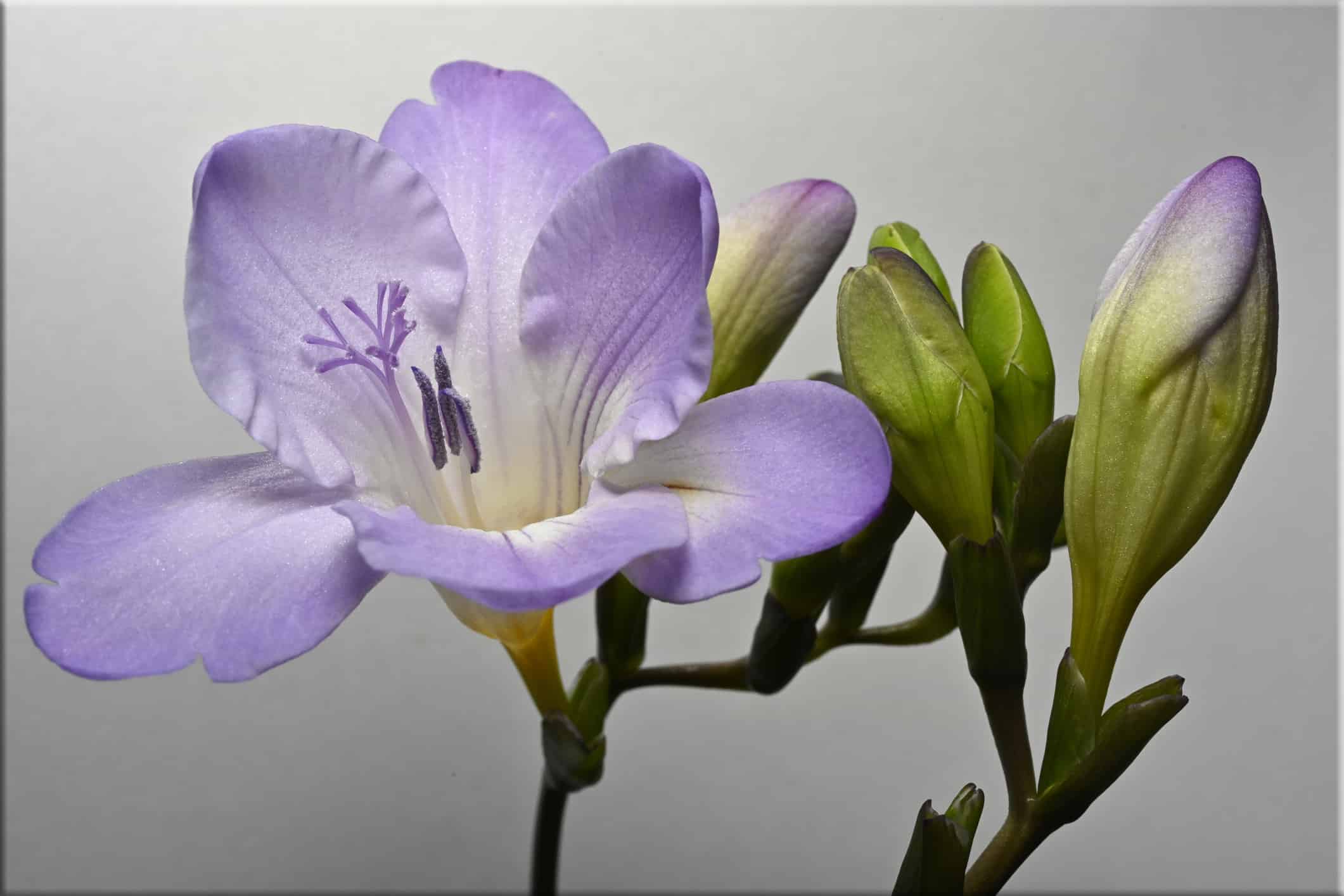Who doesn’t love freesias? These dainty blooms, with their exquisite charm, have captured the hearts of flower enthusiasts and garden lovers alike. Freesias, scientifically known as Freesia spp., are native to South Africa and belong to the Iridaceae family. These elegant flowers boast slender, elongated stems that give rise to a cluster of blossoms. Their velvety petals, shaped like tiny trumpets, open up in a mesmerizing array of hues, including shades of white, yellow, orange, pink, and purple. The vibrant colors of freesias bring a delightful touch to any garden or floral arrangement.
Beyond their visual appeal, freesias possess a captivating fragrance. The blossoms emit a sweet and enchanting scent that fills the air, adding a sense of serenity and joy to their surroundings. This delightful perfume has made freesias a popular choice for perfumes, candles, and potpourri.
In this article, we will delve into the mesmerizing allure of freesias and explore their fascinating characteristics.
What are Freesia Flowers?
Freesia flowers are enchanting and aromatic. They are a captivating species belonging to the Iridaceae family. Originating from southern Africa, particularly South Africa, these delicate blossoms have become widely cultivated across the globe, admired for their beauty and fragrance.
Classification
Freesia flowers are classified within the genus Freesia, named after Friedrich Heinrich Theodor Freese, a German physician and botanist of the 19th century. Within this genus, there are several species, including Freesia alba, Freesia caryophyllacea, Freesia fucata, and Freesia laxa, among others. These species exhibit variations in color, size, and scent, adding to the diverse allure of the freesia family.
Appearance
Freesia flowers showcase a slender and graceful structure, characterized by a spike-like inflorescence that emerges from a long, slender stem. This inflorescence possesses numerous blossoms that cluster together, creating an exquisite visual display. Each flower comprises six petals arranged in a symmetrical, tubular shape, forming a funnel-like corolla. The petals gently curve backward, giving the flower an elegant appearance.
Color and Patterns
Freesia flowers boast a vibrant array of colors, ranging from pure white and pale yellow to pink, purple, orange, and red hues. Some varieties even feature bi-colored or multicolored blooms, with distinct patterns and gradients that add depth and charm. The petals often exhibit a soft, velvety texture, adding to the tactile appeal of these blossoms.

Freesia flowers are in many colors, but they are more commonly a creamy white hue.
©iStock.com/bea8476
Fragrance
One of the most distinctive features of freesia flowers is their captivating fragrance. Their scent is sweet, fresh, and intoxicating, often described as a blend of floral and citrus notes with a hint of spice. The fragrance of freesias fills the air, making them a popular choice for perfumes, floral arrangements, and gardens, where their aroma can be appreciated and enjoyed.
Growth and Cultivation
Freesia flowers thrive in temperate climates and require well-drained soil and ample sunlight to flourish. They typically grow from bulbs, which you plant in the fall for spring blooming. Freesias are popular choices for cut flowers, as their long-lasting blooms can brighten up any room and fill it with their delightful fragrance. They also make splendid additions to gardens and landscapes, providing bursts of color and fragrance. We’ll dive more into how to grow your freesias later on in this guide.
Where Do Freesia Flowers Grow?
Freesia flowers are indigenous to southern Africa, with South Africa being the country where they first appeared. But because of extensive cultivation, they are currently growing in many places throughout the world. They are a popular option for both gardeners and florists due to their flexibility, which has helped them to thrive in many different climates and conditions.
Freesias are frequently flourishing in their natural habitat in the Cape Floristic Region of South Africa. A Mediterranean climate with moderate, rainy winters and warm, dry summers characterizes this area, which is well-known for its abundant biodiversity and advantageous growth conditions. Freesia flowers grow best in conditions that include well-drained soil, lots of sunshine, and comfortable temperatures.
Freesias have been successfully grown in other nations with comparable climate circumstances outside of their native habitat. In temperate locations like Europe, North America, Australia, and some parts of Asia, they are frequently grown. Due to their stunning beauty and pleasant aroma, they are often grown as decorative plants in these places, both in gardens and greenhouses.
Freesias are renowned for their capacity to grow in a variety of soil conditions, although they favor well-drained, slightly acidic soil. Once established, they are highly drought-tolerant and may withstand sandy or loamy soils. However, to promote proper flowering throughout their active development phase, constant hydration is a must.
Freesias are widely produced professionally as a popular cut flower in nations including the Netherlands, Kenya, and Colombia. These nations’ advantageous growing environments and sophisticated horticultural techniques enable the year-round production and exportation of freesia flowers to several international markets.
The Meaning and Symbolism Behind Freesias
Freesia flowers are frequently linked to purity and innocence. Their soft aroma and delicate look inspire a feeling of innocence and purity that is almost childlike. As a result, freesias are frequently used in weddings and christenings to symbolize the innocence and purity of the people engaged in these happy occasions.
Symbolizing Friendship and Thoughtfulness
The symbolism of friendliness and thoughtfulness is associated with freesia flowers. Freesias are symbolic of warmth, generosity, and thankfulness when given as a gift to a friend or family member. Freesias are a common flower option for showing gratitude and caring since their vivid hues, including yellow and pink, further emphasize the message of friendship and love.
Love and Romance
Freesias are also sometimes associated with love and romance. These flowers’ alluring scent is renowned for inspiring sentiments of passion and desire. Freesias are frequently a token of love and affection between couples, signifying the beauty and ferocity of their union. Freesias are a common flower option for Valentine’s Day, anniversaries, and other romantic occasions because of their romantic significance.
Symbolizing Trust and Loyalty
Freesias also have a metaphorical connotation for loyalty and trust. These blooms are elegant and “trustworthy” due to their delicate, graceful shape. In friendships and partnerships, freesias are frequently offered as a symbol of fidelity and devotion that emphasizes the value of trust and dependability.
Rebirth and Renewal
Freesias also represents rebirth and regeneration due to their vivid colors and the appearance of their blossoms in the springtime. Freesia flowers appear as nature awakens and the winter melts away, creating a sense of new beginnings and freshness. During this time, their appearance in gardens and floral arrangements denotes the beginning of a new chapter and the hope for positive development.
Occasions That Call for Freesias
With their enthralling beauty and seductive aroma, freesia flowers are a great complement to many festive events.
Weddings
Freesias are a common flower option for weddings because of their alluring presence and symbolic connotations. They are a great option for bridal bouquets, boutonnieres, and flower arrangements due to their delicate and spotless look and pleasant aroma. Freesias’ associations with purity and innocence provide an air of elegance and romance to the festive mood of a wedding ceremony.
Anniversaries
Freesia flowers are the ideal choice for commemorating a significant anniversary since they are unusual. These flowers are the perfect present to give to show someone how much you care and appreciate them since they stand for love, passion, and devotion. Freesias bring a romantic and profound touch to anniversary celebrations, reminding couples of the beauty and strength of their love, whether used alone or in a bouquet with other flowers.
Birthdays
Birthdays are a time for pleasure and celebration, and freesias may heighten the celebratory mood. Their vivacious hues, such as yellow, pink, and purple, give the event a cheery and lively feel. For a loved one’s special day, a bouquet of freesias may be a thoughtful and upbeat present that expresses care, happiness, and good wishes.
Mother’s Day
Mother’s Day is a time to celebrate and thank the moms in our lives. With their associations with love and purity, freesias are suitable flowers for this situation. They offer the perfect present for moms, expressing gratitude, admiration, and love thanks to their exquisite beauty and calming smell. Freesias bring a touch of elegance to this sincere celebration, whether they are a bouquet or as a component of a larger flower arrangement.
Tips for Growing Your Own Freesias
Growing freesia flowers is quite easy if you’ve got the right know-how.
Choosing the Right Location
Freesias thrive in locations that provide ample sunlight. Choose a good spot that gets at least six hours of direct sunlight every day. Just as well, make sure that you have well-draining soil to prevent waterlogging, which can lead to bulb rot. Freesias also prefer sheltered areas, as strong winds can damage their delicate blooms.
Preparing the Soil
Before planting freesia bulbs, prepare the soil by adding some organic matter. This can be a good compost or even quality manure. Using organic matter improves soil viability and water drainage, providing a favorable environment for the bulbs to establish and grow. Freesias tend to prefer slightly acidic soil with a pH level of around 6.0, but they are also not incredibly picky.
Planting the Bulbs
Plant freesia bulbs in the fall, about two to four inches deep and two to three inches apart. Ensure that the pointed end of the bulb faces upward. If planting in containers, use well-draining potting soil and ensure that the containers have drainage holes to prevent waterlogging.

Plant freesia bulbs in the fall, but this might vary depending on your specific hardiness zone.
©iStock.com/Ihor Hrelyuk
Watering and Maintenance
During the growing season, water the freesia plants regularly, keeping the soil slightly moist but not waterlogged. Avoid overwatering, as it can lead to bulb rot. Once the flowers start blooming, mulch around the plants to conserve moisture and suppress weed growth. Remove any spent flowers to encourage continuous blooming.
Supporting the Plants
As freesia stems are slender and can be prone to bending or breaking, consider providing support. Place stakes or use a trellis to help the plants stay upright and prevent them from leaning or falling over, especially in areas with strong winds.
Winter Care
In regions with cold winters, freesia bulbs are not frost-hardy. After the foliage has yellowed and died back, carefully dig up the bulbs and store them in a cool, dry place until the following fall. Protect the bulbs from frost by storing them in containers filled with dry peat moss or vermiculite.
There’s simply so much to love about freesias! Consider growing your flowers or buying a nice-cut bouquet of these beautiful flowers for an upcoming wedding or birthday.
Thank you for reading! Have some feedback for us? Contact the AZ Animals editorial team.








